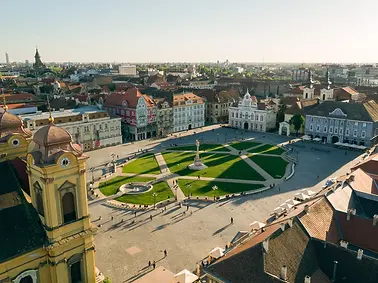
Mining, Industry and Post-Communist Transition in SW Romania
This tour highlights key industries of the region and their current states of decay or adaptation: **gold and coal mining, metallurgy, railways, heavy machinery, energy production**, and **marble extraction**. These industries are rooted in the Austrian administration's industrial expansion from the 18th century through World War I. Romania’s communist economic excesses and the post-communist transition left many of these once-thriving industrial areas in a state of surreal decay.
Along the way, we’ll visit significant cities like **Timișoara**, the former capital of the **Banat** province and the birthplace of the 1989 Romanian Revolution, as well as smaller industrial towns such as **Reșița, Anina, Hunedoara, Petroșani, Brad**, and **Târgu Jiu**—each with its own unique identity. The natural beauty of the surrounding **mountains, canyons, lakes**, and **virgin forests** adds another captivating element to this journey.
Day 1

Timisoara
We will begin with a short tour of **Timișoara**, showcasing key sites from the 1989 revolution. The tour will also include a visit to the **Timișoreana Brewery**, founded in 1718, and the former **Solventul Petrochemical Plant**, now a disused industrial site. In the evening, enjoy a welcome dinner and overnight accommodation.
Day 2
Timisoara - Resita
We will take a trip to **Oravița** (110 km), a charming mountain town known for its 19th-century Austrian architecture. After exploring the town, we’ll enjoy a relaxing lunch.
Following lunch, we’ll travel to **Anina** by train (2 hours, 30 km) along the **oldest mountain railway in Romania** (built in 1863), often compared to Austria's Semmering railway. Meanwhile, our driver will transport the coach to Anina by road. Upon arrival, we’ll visit the surface platform of the **former coal mine**, which was once the deepest in Europe at 1,250 meters, as well as the massive but never operational **oil shale power station**, one of the infamous investment failures of the communist regime.
In the evening, we’ll head to **Reșița** for dinner and overnight accommodation.

Day 3
.jpg)
Resita
In the morning, we will explore the industrial town of **Reșița**, Romania’s oldest industrial hub, with iron works dating back to 1771. We’ll visit the functioning remnants of its once-thriving heavy industry, including the **UCMR factory**, the historic **disaffected blast furnace** (now a monument), the nearby **workers' colony**, and the **Steam Locomotives Open Air Park**. Afterward, we’ll enjoy lunch in Reșița.
In the afternoon, we’ll follow the **Semenic Mountains touristic road**, where we’ll visit hydro-energetic constructions such as **dams, lakes**, and the charming **1916 Breazova small power station**, hidden in the forest and surrounded by scenic water channels.
Our journey continues to the **Semenic ski resort**, where you’ll encounter the remains of **research wind turbines**, an abandoned communist-era hotel, a **meteorological station**, and a broadcasting antenna. From here, you’ll enjoy breathtaking views of the region, including proximity to **Europe’s largest virgin beech forest**.
We will return to Reșița for the night at the same accommodation, with a free evening for dinner.
Day 4
Resita - Targu Jiu
Today, we will travel to **Herculane Baths** (100 km, 2-hour drive), a once-famous thermal resort known as the "pearl" of the 19th-century Austrian Empire, now sadly in prolonged decay. We’ll take a 30-minute break to explore the area.
Along the way, we’ll make a short stop at **Gărâna**, a charming German mountain village, and **Trei Ape Lake**. Next, we’ll visit the **Iron Gates 1 Hydro-Energetic Complex**, the largest in Europe with a capacity of 2,200 MW. We’ll spend 30 minutes to an hour at the museum, which provides fascinating views into the machinery hall.
We’ll then head to **Turnu Severin** for lunch before continuing to the **Motru surface coal exploitations**. Afterward, we’ll visit the **Lafarge Cement Factory** in **Târgu Jiu** and explore the famous **Brâncuși sculpture ensemble**.
Accommodation will be in **Târgu Jiu**, with a free evening for dinner.

Day 5

Targu Jiu - Hunedoara
In the morning, we will explore the abandoned mining sites of the **Jiu Valley**, including **Petrila, Paroșeni, Uricani**, and **Aninoasa**. We’ll also visit the **narrow-gauge industrial railway** from Petrila to Lonea, as well as the town of **Petroșani**. Lunch will be enjoyed along the way.
In the afternoon, we’ll head to **Hunedoara** (80 km, approximately 1 ¼ hour drive) for accommodation, with the evening free for dinner.
Day 6
Hunedoara
Today, we’ll head to the Roșia Montană gold mining site (90 km, 1 ½-hour drive) to explore its ancient galleries and museum, learning about the area's rich mining history.
Next, we’ll take a scenic steam train ride along the Brad-Crișcior narrow railway, followed by a visit to the Brad Mining Museum. After lunch in Brad, we’ll return to Hunedoara (50 km, 1-hour drive) to visit the remnants of the metallurgic industry and the historic Govăjdia blast furnace, built in 1806.
We’ll spend the night at the same accommodation in Hunedoara, with a free evening for dinner.

Day 7

Hunedoara - Timisoara
The day will begin with a visit to the magnificent Corvin Castle, one of the most iconic Gothic-style castles in Europe. Afterward, we’ll explore Călan, once a thriving center of metallurgic industry, now in decline.
Next, we’ll travel to Rușchița (80 km, 1 ½-hour drive) to visit the famous marble quarry, followed by lunch.
In the afternoon, we will continue to Recaș Winery (120 km, 2-hour drive), near Timișoara, for a tour and farewell dinner with a wine tasting experience.
Accommodation will be in Timișoara.
Day 8
Departure Home
Transfer to the airport.
Services Include:
-
Minibus with A/C and bar
-
English-speaking guide
-
Half board, including special dinners and wine tastings as per the program
-
Meetings with professionals at various industrial sites
Prices:
-
Double/twin room: €1,599
-
Single supplement: €260
